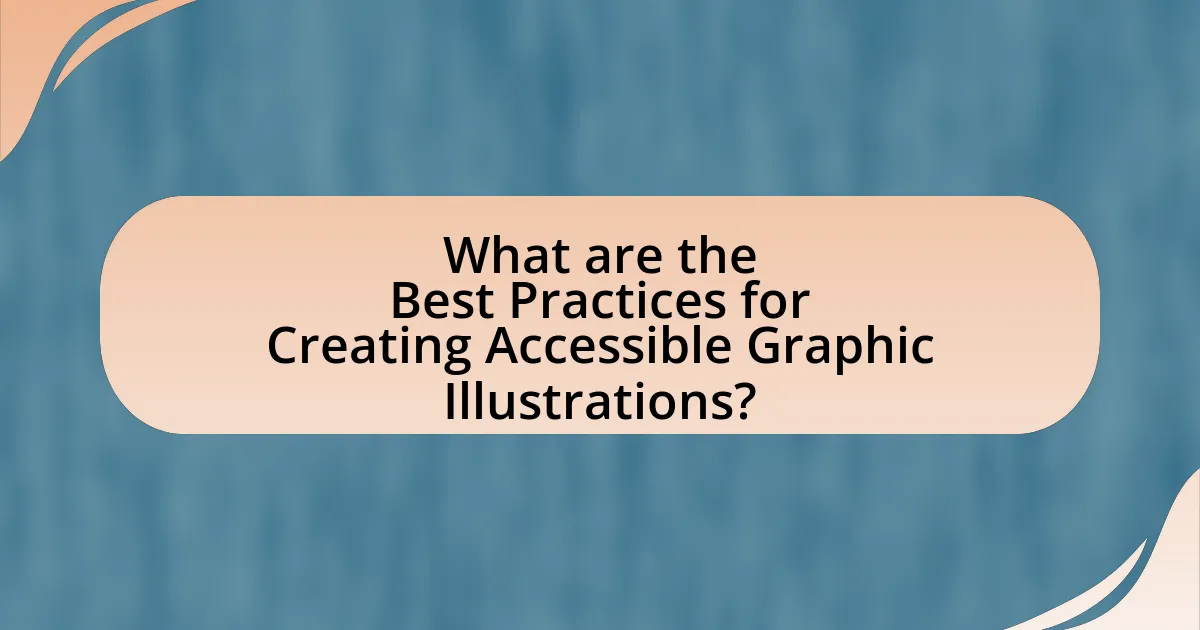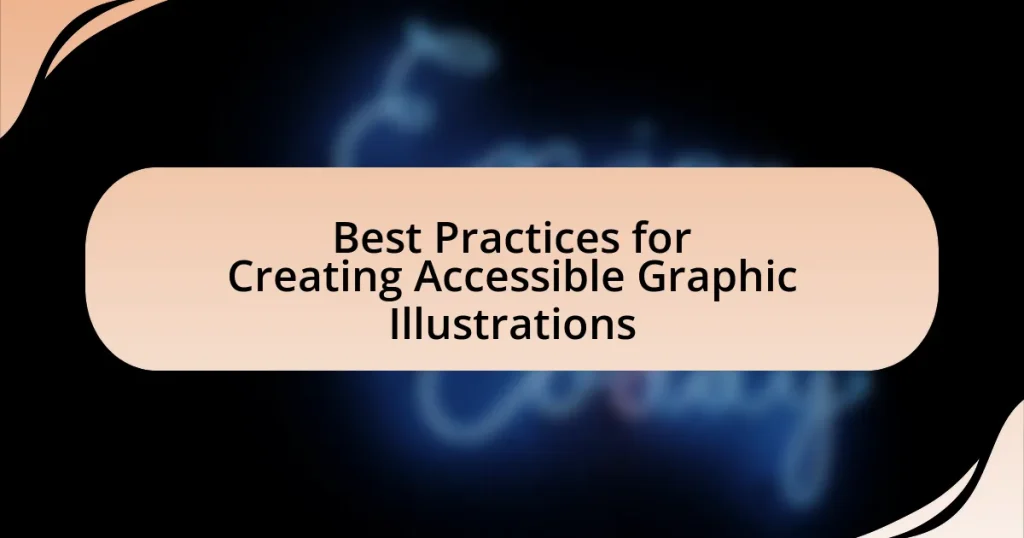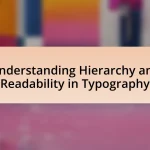The article focuses on best practices for creating accessible graphic illustrations, emphasizing the importance of inclusivity in design. Key practices include using high-contrast colors, providing alternative text descriptions, ensuring scalability, and avoiding reliance on color alone to convey information. It discusses the significance of accessibility for individuals with disabilities, legal requirements such as the Americans with Disabilities Act (ADA), and the impact of accessibility on user experience. Additionally, the article outlines common mistakes to avoid, the role of technology in enhancing accessibility, and practical tips for implementing accessible graphic illustrations effectively.

What are the Best Practices for Creating Accessible Graphic Illustrations?
The best practices for creating accessible graphic illustrations include using high-contrast colors, providing alternative text descriptions, ensuring scalability, and avoiding reliance on color alone to convey information. High-contrast colors enhance visibility for individuals with visual impairments, while alternative text descriptions allow screen readers to convey the content of the illustrations to users who cannot see them. Scalability ensures that illustrations remain clear and legible at different sizes, accommodating various devices and user preferences. Additionally, using patterns or textures alongside color helps convey information to those who are colorblind, making the illustrations more inclusive. These practices align with the Web Content Accessibility Guidelines (WCAG), which emphasize the importance of accessibility in digital content.
Why is accessibility important in graphic illustrations?
Accessibility is important in graphic illustrations because it ensures that visual content can be understood and appreciated by individuals with diverse abilities, including those with visual impairments. By incorporating accessibility features, such as alternative text and high-contrast colors, graphic illustrations can effectively communicate information to a broader audience. Research indicates that approximately 15% of the global population experiences some form of disability, highlighting the necessity for inclusive design practices. Accessible graphic illustrations not only comply with legal standards, such as the Web Content Accessibility Guidelines (WCAG), but also enhance user engagement and satisfaction, ultimately benefiting creators and consumers alike.
How does accessibility impact user experience?
Accessibility significantly enhances user experience by ensuring that all individuals, regardless of their abilities, can effectively engage with content. When graphic illustrations are designed with accessibility in mind, they become more inclusive, allowing users with disabilities, such as visual impairments, to comprehend and interact with the material. For instance, incorporating alt text for images enables screen readers to convey visual information to users who cannot see the illustrations. Research indicates that accessible design can improve overall user satisfaction and engagement, as evidenced by a study from the World Health Organization, which found that inclusive practices lead to a 20% increase in user retention on digital platforms. Thus, prioritizing accessibility not only broadens the audience but also enhances the overall effectiveness of communication through graphic illustrations.
What are the legal requirements for accessibility in design?
The legal requirements for accessibility in design primarily stem from the Americans with Disabilities Act (ADA) and Section 508 of the Rehabilitation Act. The ADA mandates that public spaces, including digital environments, must be accessible to individuals with disabilities, ensuring equal access to services and information. Section 508 specifically requires federal agencies to make their electronic and information technology accessible to people with disabilities, aligning with the Web Content Accessibility Guidelines (WCAG) 2.0 Level AA standards. These regulations are enforced to promote inclusivity and prevent discrimination, with legal consequences for non-compliance, such as lawsuits and fines.
What are the key principles of accessible graphic design?
The key principles of accessible graphic design include clarity, contrast, simplicity, and inclusivity. Clarity ensures that visual elements communicate their intended message effectively, while contrast enhances readability and visibility for users with visual impairments. Simplicity reduces cognitive load, making designs easier to understand, and inclusivity involves considering diverse user needs, including those with disabilities. Research indicates that applying these principles can significantly improve user experience and accessibility, as highlighted in the Web Content Accessibility Guidelines (WCAG) established by the World Wide Web Consortium (W3C).
How can color contrast enhance accessibility?
Color contrast enhances accessibility by improving the visibility of text and graphical elements for individuals with visual impairments. High contrast between foreground and background colors allows users to distinguish content more easily, which is crucial for readability. Research indicates that adequate color contrast can significantly reduce the cognitive load on users, making information more accessible. For instance, the Web Content Accessibility Guidelines (WCAG) recommend a minimum contrast ratio of 4.5:1 for normal text to ensure that users with low vision can read content effectively.
What role does typography play in accessibility?
Typography plays a crucial role in accessibility by enhancing readability and comprehension for diverse audiences. Effective typography, including font choice, size, spacing, and contrast, directly impacts how easily individuals, particularly those with visual impairments or cognitive disabilities, can engage with text. Research indicates that using sans-serif fonts, maintaining a minimum font size of 12-14 points, and ensuring sufficient contrast between text and background can significantly improve accessibility. For instance, the Web Content Accessibility Guidelines (WCAG) recommend specific contrast ratios to ensure text is legible for users with low vision. Thus, thoughtful typography design is essential for creating inclusive graphic illustrations that accommodate all users.
How can technology assist in creating accessible graphic illustrations?
Technology assists in creating accessible graphic illustrations by providing tools that enhance visual clarity and usability for diverse audiences. Software applications like Adobe Illustrator and Canva offer features such as alt text integration, color contrast checkers, and customizable templates that cater to various accessibility needs. For instance, color contrast analyzers ensure that illustrations meet WCAG (Web Content Accessibility Guidelines) standards, making them easier to perceive for individuals with visual impairments. Additionally, screen reader compatibility in design software allows visually impaired users to understand graphic content through audio descriptions. These technological advancements facilitate the creation of inclusive illustrations that effectively communicate information to all users.
What tools are available for checking accessibility?
Tools available for checking accessibility include automated testing tools, browser extensions, and manual evaluation methods. Automated testing tools like Axe, WAVE, and Lighthouse analyze web content for accessibility issues based on established guidelines such as WCAG (Web Content Accessibility Guidelines). Browser extensions, such as the Accessibility Insights for Web, provide real-time feedback on accessibility compliance while users navigate websites. Manual evaluation methods involve user testing with individuals who have disabilities to identify practical accessibility challenges. These tools collectively help ensure that graphic illustrations and web content are accessible to all users, reinforcing the importance of inclusivity in design.
How can software features improve accessibility in illustrations?
Software features can improve accessibility in illustrations by incorporating tools that enhance visual clarity and provide alternative text descriptions. For instance, features like adjustable contrast, text-to-speech capabilities, and customizable color palettes allow users with visual impairments to better perceive and understand illustrations. Additionally, software that supports screen readers can automatically generate descriptive tags for images, ensuring that visually impaired users receive context about the content. Research indicates that implementing these features can significantly increase engagement and comprehension among users with disabilities, thereby fostering inclusivity in visual communication.
What common mistakes should be avoided in accessible graphic design?
Common mistakes to avoid in accessible graphic design include using insufficient color contrast, neglecting alternative text for images, and failing to consider text readability. Insufficient color contrast can make content difficult to read for individuals with visual impairments; for example, the Web Content Accessibility Guidelines (WCAG) recommend a contrast ratio of at least 4.5:1 for normal text. Neglecting alternative text deprives screen reader users of essential information, as images without descriptions cannot be interpreted. Additionally, using overly complex fonts or small text sizes can hinder readability, particularly for those with dyslexia or low vision. These mistakes compromise the accessibility of graphic designs, making it crucial to adhere to established guidelines and best practices.
How can over-reliance on color be problematic?
Over-reliance on color can be problematic because it may lead to accessibility issues for individuals with color vision deficiencies. Approximately 1 in 12 men and 1 in 200 women have some form of color blindness, which means that relying solely on color to convey information can exclude a significant portion of the population. For instance, if a graph uses red and green to differentiate data points, those with red-green color blindness may not be able to distinguish between them, resulting in misinterpretation of the information presented. Therefore, incorporating additional visual cues, such as patterns or labels, is essential to ensure that graphic illustrations are accessible to all users.
What are the pitfalls of using complex imagery?
The pitfalls of using complex imagery include potential confusion and misinterpretation by the audience. Complex imagery can overwhelm viewers, leading to difficulty in understanding the intended message. Research indicates that cognitive load increases with intricate visuals, which can hinder information retention and comprehension. For instance, a study published in the journal “Cognitive Science” by Sweller et al. (2011) demonstrates that excessive detail in graphics can detract from learning outcomes. Additionally, complex imagery may pose accessibility challenges for individuals with visual impairments, as screen readers often struggle to convey intricate details effectively.
How can feedback improve the accessibility of graphic illustrations?
Feedback can significantly enhance the accessibility of graphic illustrations by identifying specific barriers that users may encounter. When individuals provide input on their experiences with graphic content, designers can gain insights into how effectively the illustrations communicate information to diverse audiences, including those with disabilities. For instance, feedback may reveal that certain color contrasts are insufficient for individuals with visual impairments, prompting adjustments to improve visibility. Research indicates that user-centered design, which incorporates feedback, leads to more inclusive outcomes, as evidenced by studies showing that iterative testing with real users can increase comprehension and usability by up to 50%. Thus, integrating feedback into the design process ensures that graphic illustrations are more accessible and effective for all users.
What methods can be used to gather user feedback on accessibility?
Surveys and questionnaires are effective methods to gather user feedback on accessibility. These tools can be designed to assess users’ experiences and challenges with accessibility features in graphic illustrations. For instance, a study by the World Health Organization indicates that structured surveys can yield quantitative data that helps identify specific accessibility barriers faced by users. Additionally, usability testing sessions allow users to interact with graphic illustrations while providing real-time feedback, which can highlight practical accessibility issues. According to research published in the Journal of Usability Studies, direct observation during usability tests can reveal insights that surveys alone may not capture.
How can iterative design enhance accessibility outcomes?
Iterative design enhances accessibility outcomes by allowing continuous refinement based on user feedback, which leads to more inclusive solutions. This process involves repeated cycles of prototyping, testing, and revising designs, ensuring that the needs of diverse users, including those with disabilities, are addressed effectively. Research indicates that involving users with disabilities in the design process can significantly improve usability; for instance, a study by the University of Washington found that user-centered design approaches increased accessibility satisfaction ratings by over 30%. By prioritizing user input throughout the design phases, iterative design fosters an environment where accessibility is not an afterthought but an integral part of the development process.
What are some practical tips for implementing accessible graphic illustrations?
To implement accessible graphic illustrations, ensure that all visuals include alternative text descriptions that convey the essential information. This practice allows individuals using screen readers to understand the content and context of the illustrations. Additionally, use high-contrast colors to enhance visibility for users with visual impairments, as studies show that contrast improves readability. Incorporating clear and simple designs helps avoid confusion, making it easier for all users to interpret the information presented. Furthermore, consider providing captions or transcripts for any audio or video components associated with the illustrations, as this supports users with hearing impairments. Lastly, test the illustrations with real users, including those with disabilities, to gather feedback and make necessary adjustments, ensuring that the graphics meet diverse accessibility needs.


